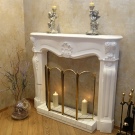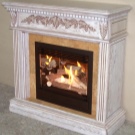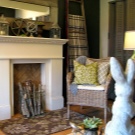Fireplace made of polyurethane with your own hands
The presence of a fireplace in the house has always been considered an indicator of wealth and high social status of its owners. Until recently, only the owners of dachas or private houses could afford the installation of a fireplace (this was due to the impossibility of arranging the chimney in apartments). But today, thanks to the rapid development of technology, everyone can decorate their home with such a wonderful element of decor. In particular, almost every owner can make a fireplace out of polyurethane with his own hands. About all the intricacies of its arrangement, we will talk further.
Advantages of polyurethane
Such material as polyurethane, has a number of advantages. Among them are:
- impact resistance - the material is well resistant to pressure and blows of almost any force (this is especially important for families with overly active children);
- thermal stability - polyurethane retains its performance at very low and high temperatures (from -40 to +80 degrees);
- fire safety - of course, this material will not survive the direct impact of fire, but it will melt rather than burn, and this significantly reduces the likelihood of a large fire expanding;
- aesthetics - the appearance of polyurethane structures is quite elegant, so that they easily fit into the interior;
- easy installation of structures (for this purpose, you can use both glue and special fasteners);
- long service life - polyurethane structures are guaranteed to last more than 10 years (a more accurate period depends on the conditions of use).
As you can see, this material has really many advantages. Let's find out how to build fireplaces with it.
Styles
Before installing the fireplace, you must first decide on the style of its future design. In total there are 4 stylistic options.
- Classic - perfect for those who love the old days. Usually such models are decorated with stucco, columns or specific patterns characteristic of the 19-20th century.
- Constructivism - this design style reflects the characteristics of the entire room.In such situations, the fireplace is harmoniously combined with the entire room in color, geometry, dimensions.
- High-tech is a way of arrangement suitable for those who wish to design all their housing according to the canons of the 21st century.
- Modern is a universal style that suits both lovers of antiquity and admirers of the latest technologies. As a rule, with this design, the design combines elements of classic and high-tech.
Choosing the future style of framing, you need to take into account a number of factors: the subsequent use of the fireplace (simple decor or a full heater), the design of the entire room, the degree of natural and artificial lighting of the room, material possibilities.
What is required for work?
To create a fireplace made of polyurethane, you need to acquire such tools and parts:
- polyurethane elements themselves;
- a large sheet of paper (for drawing);
- ruler;
- simple pencil;
- measuring tape;
- stusloma;
- docking glue;
- mounting glue;
- fine-grained pelt;
- spatula;
- hacksaw;
- a drill;
- self-tapping screws.
Before starting work, it is necessary to measure the place in which the installation of the fireplace is planned.Based on the obtained values, you should draw a drawing. Only after that can one take up the bulk of the work.
How can work go?
There are 2 options for creating a fireplace. The first option is as simple and fast as possible. It involves the purchase of blanks, from which then, like a designer, a ready-made fireplace is assembled. Purchase such blanks can be in many places. For example, you can buy billet for home fireplace from the company Europlast.
The first option has its pros and cons. Of the advantages we can distinguish the speed and ease of assembly. But the main disadvantage is the fact that purely polyurethane you can only make a decorative fireplace, which will not play the role of a heater (this is due to the susceptibility of the material to temperatures in excess of 80 degrees).
If you choose the second option, you have to do everything yourself: from the drawing to fixing the last part. However, this approach can use additional materials (for example, drywall). If you do the work on the second option, you will have a full-fledged fireplace, which will become not only an elegant addition to the interior, but also a good heater.
Drawing Tips
As mentioned above, before starting all the work, it is necessary to measure the area where the placement of the fireplace is planned. Then you need to make a drawing. When creating a drawing, it is recommended to follow these principles:
- Fireplace support should be slightly longer than its upper shelf (for example, the length of the lower part can be 160 cm, and the top - 150 cm);
- the height of the lower pedestal should be between 15 and 20 cm;
- the overall height of the structure should be up to one and a half meters (so that the fireplace does not look too bulky);
- the height of the side panels, which can be set aside under the "columns", should be 60-80 cm;
- the fireplace portal should look like a rectangle, but the lengths of the sides should differ slightly (by a maximum of 15 cm);
- there should be something like another pedestal between the top of the fireplace portal and the top of the whole structure (its height should be 20-25 cm);
- the thickness of the upper shelf of the fireplace should be small (up to 10 cm).
Assembly process
After preparing the drawing, you must perform the following actions:
- markup on polyurethane elements;
- cut all the details of the future design with a saw;
- match the different elements precisely (their dimensions should correspond to the drawing indicators);
- Attach different components to each other to see if they are touching correctly.
- after checking all the details, begin to fasten them with mounting glue or self-tapping screws;
- after work, install the fireplace in its allotted place.
Fastening elements can be combined (i.e., some parts can be sealed with glue, and others with self-tapping screws). Parts connected only with glue look more aesthetically pleasing, but mounting with screws is considered more reliable.
If during the work you will use the plasterboard frame (in order to place the stove inside the portal later), the procedure will be the same. However, you have to think in advance about the size of the stove and take a place under the wires through which the furnace will be connected to the mains. In addition, you will need to carry out additional work on the arrangement of external stucco polyurethane.
Principles of fastening stucco
Framing the fireplace with polyurethane stucco will give it an incredibly elegant look. Such work can be done in two ways.
The first method involves adhesive bonding. With this approach, the surface is first degreased and well dried. Then the first layer of glue is applied on it.When this layer dries, glue is applied to the inner surface of the stucco. Elements of stucco applied to the desired point, after which they are given time to dry (as a rule, the glue sets very quickly).
The second method requires mechanical fastening. Nails and screws are used here. Before work begins, the surface of the fireplace frame is drawn so that all the elements of the stucco molding are laid down properly. Then each part is applied to the surface of the frame and is attached with screws.
The final stage of decoration
The final stage of work is the decoration of the finished design. Here everything will depend on your preferences. Fireplace can be painted in any color that will fit the design of the entire room. If the design is decorative, the fireplace portal can be decorated with a vase with flowers, topiary, a picture that will imitate fire.
Also, you can decorate the upper part of the structure. For example, on the top of the fireplace you can place family photos, miniature crafts, souvenir plates, etc. If inside the structure there is still a real electric furnace, in front of the fireplace you can use the mat to warm your whole family.



































































